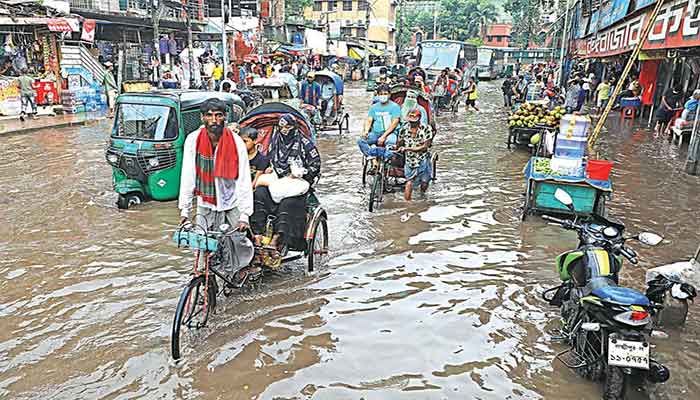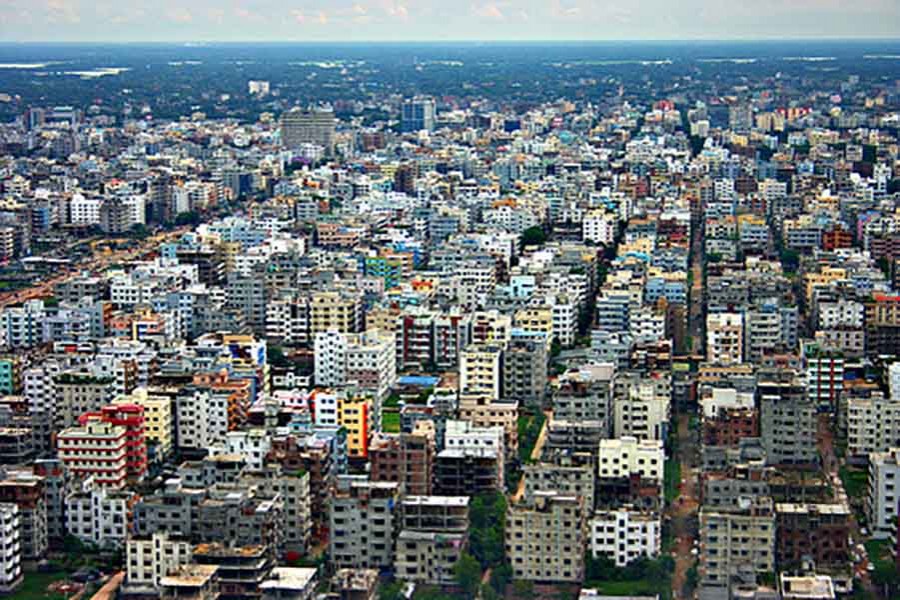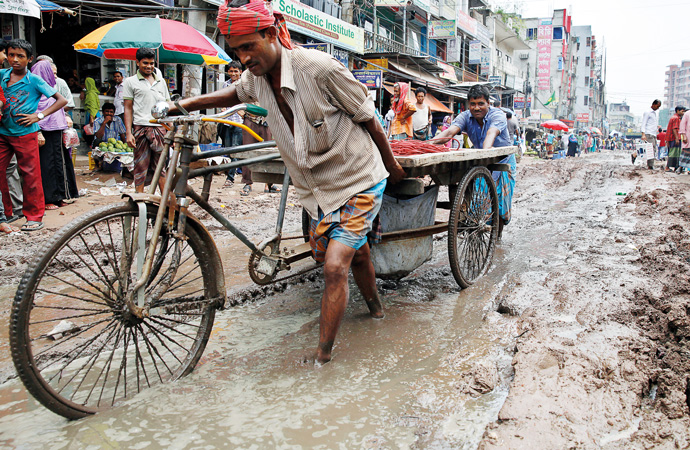
Desk Report
Publish: 18 Jun 2021, 05:10 pm

Photo: Collected
The rise and fall of the deadly virus Corona have disrupted human life. It has raised the question of government health system day after day and the growth of corporate hospitals. The sand dams of the capitalist system have also begun to break around the world. This tiny virus has taught us what to do and what not to do to survive as a child of nature. Resources cannot be destroyed. After all, people are now desperate to find a Corona-free society or housing. Somehow hiding or fleeing it will be possible to lead a normal life free from the deadly virus, but this year the killer seems to be more horribly invisible. Negative impact is on the economy. Education, health, and politics are no exception. Right now, a survey report came out that Dhaka-- the capital of the country-- is at the bottom of the list of 140 cities in terms of livability. The Economist Intelligence Unit's (EIU) list of Covid-19 epidemics has undergone a major overhaul, with Dhaka advancing just one step in two years. Last time the 400-year-old city was at number three at the bottom of the list, this time at number four, that is, at number 137. In order to understand how livable a city, EIU examines sustainability, healthcare, culture and environment, education and infrastructure. Dhaka's total score in the 100-based index is 33.5 this time, with Auckland, New Zealand topping the list with a score of 96. Dhaka got the lowest score in the health sector which is 16.7. In terms of infrastructure, the score of 26.8 and culture and environment are the lowest among the 140 countries in the list. Apart from this, the organization has given a score of 55 in Dhaka and 33.3 in education in terms of stability. Below Dhaka are Port Moresby in Papua New Guinea, Lagos in Nigeria, and finally Damascus in Syria.
 (Photo: Collected)
(Photo: Collected)
‘Capital Dhaka’ and ‘civic problem’ have become synonymous long ago. The rivers Buriganga, Turag, Shitalakshya, and Balu, which were once under the control of the occupation, have turned into a swamp. Planned urban management is not keeping pace with increasing urbanization and rapid urbanization. As a result, living standards and environment are severely neglected in the planning and implementation of infrastructure-based development, including unequal distribution of civic benefits and formulation of extreme discriminatory policies. Considering the safety of people of all classes, professions, and ages, a livable and environmentally friendly city for people is, therefore, one of the major problems of Dhaka. A study by the Bangladesh University of Engineering and Technology (BUET) found that 73 percent of the city's scattered infrastructure is completely unplanned. Due to this, the capital has become a city of traffic jams and waterlogging. Added to that is the stench in the water, the dilapidated condition of the roads, the manholes without lids, the piles of garbage everywhere, the housing crisis with the torment of mosquitoes and flies. Multi-storey residential and commercial buildings have been constructed without following the proper policy of land use. The drainage system of the capital has become uncontrolled due to the reckless development that has taken place by filling the water bodies and low-lying areas. Transport sector disrupted due to inadequate road system. Although the residents of the city need 25 percent of the total road area for their smooth travel, there is only 6 percent. Due to this the traffic jam is constantly increasing. According to the latest survey of the United Nations Development Program (UNDP), the annual loss due to traffic congestion in Dhaka is Tk 35,100 crore.
 (Photo: Collected)
(Photo: Collected)
Urban planners say Dhaka does not have much of the conditions needed to build an ideal city. Again, the master plans that have been taken have not been implemented. Everything has been isolated and scattered. As a result, while solving one problem, another problem has become more evident. There is a lack of coordination. Different organizations take, plan and implement projects on their own. Lack of coordination causes one project to clash with another. The flyovers have been built to reduce traffic congestion in the city, in some cases seen as a major obstacle to other projects and plans. Chittagong University of Engineering and Technology, Assistant Professor of Urban and Regional Planning. Shah Jalal Mishuk said, "In 1917, the British urban planner Sir Patrick Gaddis made a plan for the city of Dhaka. Then in 1959 a 20-year master plan was drawn up for Megacity Dhaka. It includes several infrastructures, residential areas, commercial areas; But the whole plan was never implemented. Moreover, the plan was for 1.5 million people. In 1974, the population of Dhaka stood at about 20 lakhs. 35 lakh in 1980. And in 1991 it was 65 lakh. In 2001, the population of this metropolis stood at over one crore. And now about two crores. Dhaka city is still running with the plan for 1.5 million people. The plans that were made later have been implemented to a lesser extent."
Bangladesh Institute of Planners (BIP) General Secretary Adil Muhammad Khan said, ‘A livable city needs 20 percent green space, 10 to 15 percent water bodies, and 20 to 25 percent roads. In this case, there is not much opportunity to re-arrange the previous Dhaka. However, the 36 new wards that have been added to the two city corporations need to be developed in a planned manner. There is a need to work in line with global standards in planning. 'Citing EIU figures, the city planner said,' As the capital, Dhaka's infrastructure, transportation facilities, waterlogging is not well in any index. There is a problem with the quality of our plans. These are not world-class. Apart from this, as much as there is a plan, it is not implemented. In many cases, the interest groups are involved in the planning process and try to do it to their advantage. In addition, there is a severe lack of good governance among the agencies involved in the implementation of the plan.
 (Photo: Collected)
(Photo: Collected)
It is surrounded by four rivers, connected by numerous canals that run through the heart of the city. Absolutely what is called a natural city. At the same time, there is no shortage of projects to build Dhaka for hundreds of years. Development sacrifices continue throughout the year; but in this hot city, the rain is more of a curse than a blessing. The highways are slightly waterlogged. An intense traffic jam is created. Nearly two crore people of this city have to live in anxiety and misery mainly due to the closure of the drainage system. Capital Development Authority (RAJUK) officials say residential, commercial, industrial, road, open space, water bodies and floodplain areas have been identified in the area covered by Dhaka's Detailed Area Plan 2010 (DAB). However, influential people and private housing companies are filling up water bodies, canals and lowlands and constructing one plot and flat after another. Due to this, waterlogging is constantly increasing in the capital and surrounding cities. Besides, it is also affecting the natural balance and temperature of the city. Dr. Adil Muhammad said, "Our groundwater is not being recharged due to lack of open space and water bodies. As a result, it gets very hot during hot weather. As the canals and reservoirs are occupied, there is no place for rainwater to flow. That is why waterlogging is created with a little rain. "
 (Photo: Collected)
(Photo: Collected)
Despite all the problems in Dhaka, urban planners do not find this analysis of the Economist Intelligence acceptable. According to them, this difference between city and city is essentially an assessment subject to investment and tourism-based reviews. Glamorous city prevails there. Therefore, it would not be wrong to call the cities with which Dhaka has been compared in this list as very unpopulated cities. BIP President and Professor of Urban and Regional Planning at Jahangirnagar University. Akhtar Mahmood said, "The population density of Auckland or Wellington is negligible compared to Dhaka. If the population of any one area of Dhaka can be included in these cities, then the whole system may collapse. However, this does not mean that there is no problem with livability in Dhaka city. Considering Dhaka in terms of its potential, it lags far behind. In that sense, the question of livability arises; but the Economist Intelligence Unit has failed to consider us from the perspective of the city of life, the city of humanity, the city of man. That is why the controversy over Dhaka's position remains on their list."
He added, "Every year, Dhaka's position reminds us of the failure and irresponsibility of our policymakers who are at the bottom." The organization did not release its report last year on the Corona situation. Compared to 2019, we are one step ahead in the rankings on paper, but in reality, the situation is worse. In the last published list, the index value was 39.2 out of 100, and now it is 33.5. Corona situation has dragged all the cities. However, the plight of our health sector has come to the fore in this critical period. The poor state of the health sector has had a big impact on the rankings. In this index, we are 13 behind compared to 2019, which is the highest. The environmental challenge is ours for a long time. In the last year, our city has been at the top or second in terms of air pollution for quite some time. While other cities are doing well in Corona, our situation is as fragile as ever. So if we want to improve now, we have to put our hands in the basic place. In addition to fixing the health system, we also have to help in education. But look, the educational institution in Corona is completely closed. Because of this, we may have lagged behind in the education index. There are very few countries in the world where educational institutions are closed like this."
Subscribe Shampratik Deshkal Youtube Channel
Topic : Others Liveability Index
© 2024 Shampratik Deshkal All Rights Reserved. Design & Developed By Root Soft Bangladesh